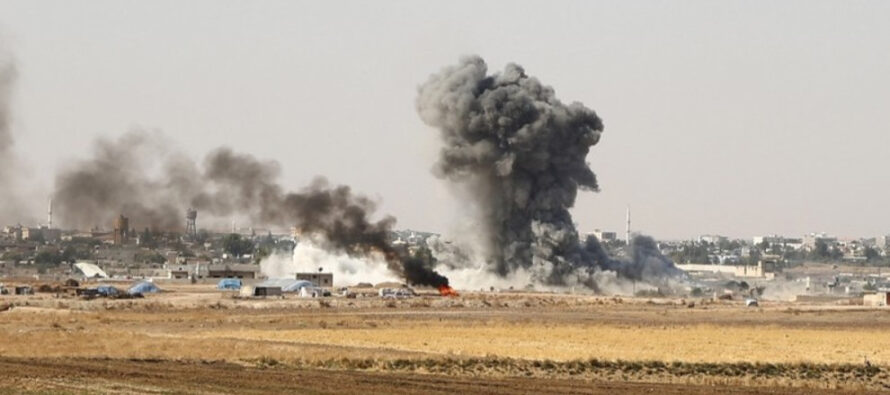They call it ceasefire

![]()
Despite the ceasefire agreed in Sochi, which expired on Tuesday, the attacks by the Turkish army and its jihadist mercenaries in northern Syria have continued all along.
Despite the agreement reached on 22 October in Sochi between Russia and Turkey, which established a 150-hour ceasefire in Northern Syria from 23 to 29 October, the air and ground attacks by the Turkish army and its jihadist mercenaries have gone on all along.
The Syrian Democratic Forces (SDF) announced on 27 October that, as a result of talks with Russia, they would “reposition” their units and accept the deployment of Syrian central government troops on the border line.
Even after this development, the Turkish attacks have not abated. During the period of the alleged ceasefire, the attacks were concentrated on Serêkaniyê (Ras al-Ain) and Ayn Issa. Turkey expanded its zone of occupation and many civilians were kidnapped or murdered.
Cemila Heme, co-chair of the Kurdish Red Crescent (Heyva Sor a Kurd), told ANF that since 23 October four civilians had been killed by the Turkish state and its jihadist mercenaries in the Cizîrê region only, and a further 79 had been injured.
According to Heyva Sor figures, a total of 1032 people have been injured in Cizîrê region since 9 October. Of these, 65 are minors and 147 are women. 202 civilians were killed, including eight minors and twenty women.
The balance of the 150 hours of alleged ceasefire is listed as follows:
October 23
The Turkish jihadist invasion troops attacked the areas of Serêkaniyê, Dêrik, Kobanê and Ayn Issa. These included the use of armed drones. 16 SDF fighters lost their lives, 13 others were injured. The SDF responded to the attacks on the basis of legitimate defense. During the fighting 50 jihadists were killed.
October 24
The invading troops attacked Serêkaniyê, Kobanê, Dêrik, Amûdê, Dirbêsiyê and Ayn Issa. Three SDF fighters were martyred, four others were injured. At least 31 mercenaries were killed and 20 injured in the ensuing clashes.
October 25
The Turkish attacks continued in the surroundings of Serêkaniyê, Kobanê and Ayn Issa. Among other weapons, armed drones and heavy weapons were used. Three SDF fighters were martyred and another four injured. At least 44 mercenaries were killed in combat.
October 26
The invading troops carried out attacks in Serêkaniyê, Kobanê, Amûdê, Dirbêsiyê and Ayn Issa. One SDF fighter was martyred, eleven others were injured. At least 29 mercenaries were killed in the fighting.
October 27
The attacks of the invading troops continued in Serêkaniyê, Kobanê and Ayn Issa. A drone attack in the Zirgan town near Serêkaniyê killed three Syrian army soldiers and injured four others. At least 38 mercenaries were killed in battle.
October 28
There were attacks in the areas of Serêkaniyê, Zirgan and Dirbêsiyê, Til Temir and Serêkaniyê as well as Kobanê and Ayn Issa. During the attacks 13 SDF fighters were martyred and twelve Syrian soldiers were injured.
Civilians Mehmud Zahêr (60) and Berho Elo (65) died in an attack on the village al-Arida in the north of Ayn Issa. Three civilians were killed in an attack on the village Dibish near Zirgan. At least 56 mercenaries were killed in the fighting that erupted following the legitimate defense of the SDF.
Related Articles
L’ETA SOSPENDE LE ATTIVITA’ ARMATE
![]()
Con un video recapitato alla BBC, l’ETA ha dichiarato la sospensione delle attività armate. Nel video si vedono tre militanti
PKK leader says Dicle ban may amount to declaration of war
![]()
TODAYSZAMAN PKK leader Murat Karay?lan (C) Outlawed Kurdistan Workers’ Party (PKK) leader Murat Karay?lan said the ban of a pro-Kurdish
LA KNESSET BLINDA LA RESITUZIONE DELLE ALTURE DEL GOLAN E GERUSALEMME EST
![]()
Gara. Il Comitato Affari Interni della Knesset approvò ieri, per cinque voti contro due, un progetto di legge che dovrà


